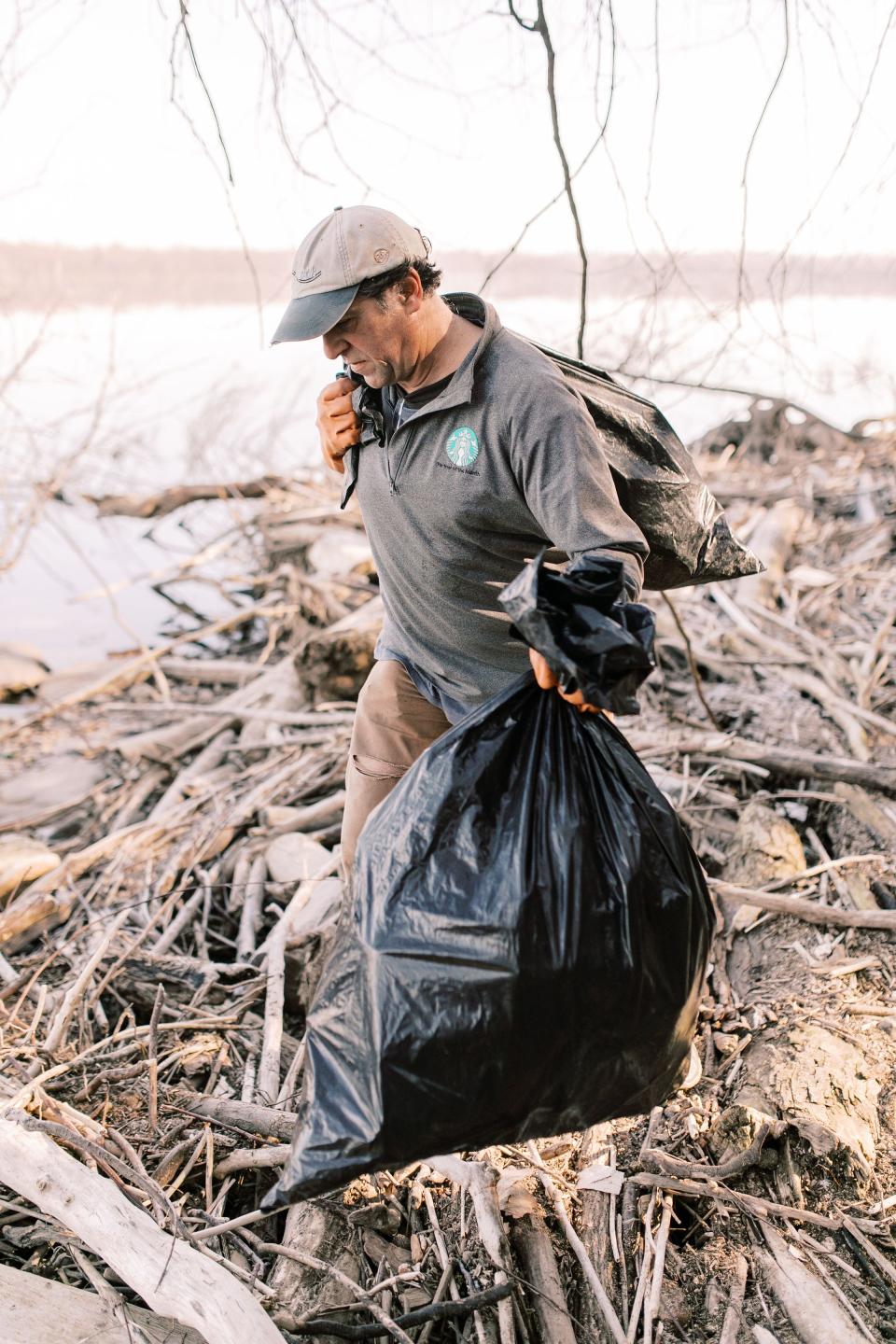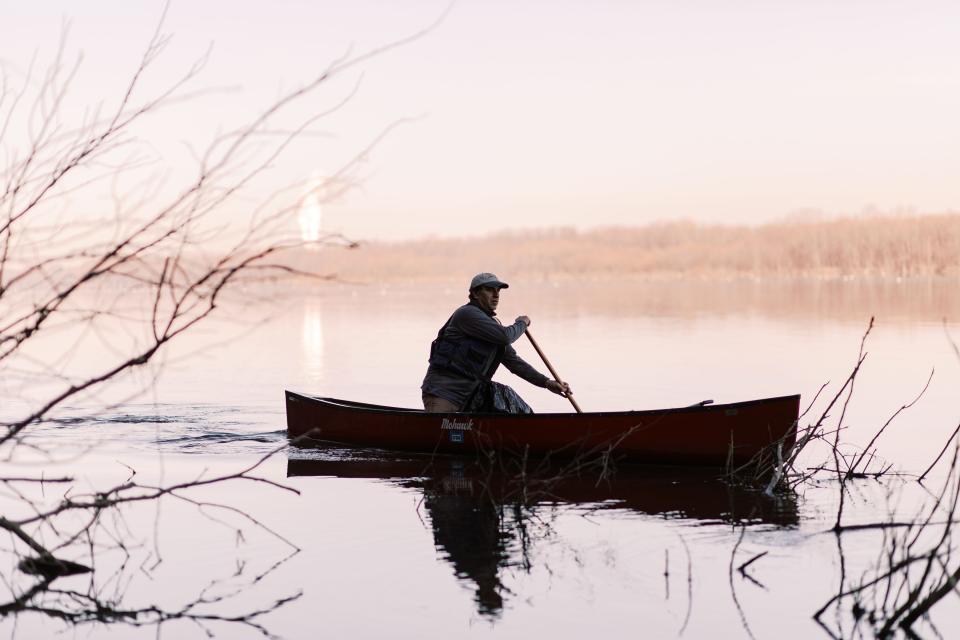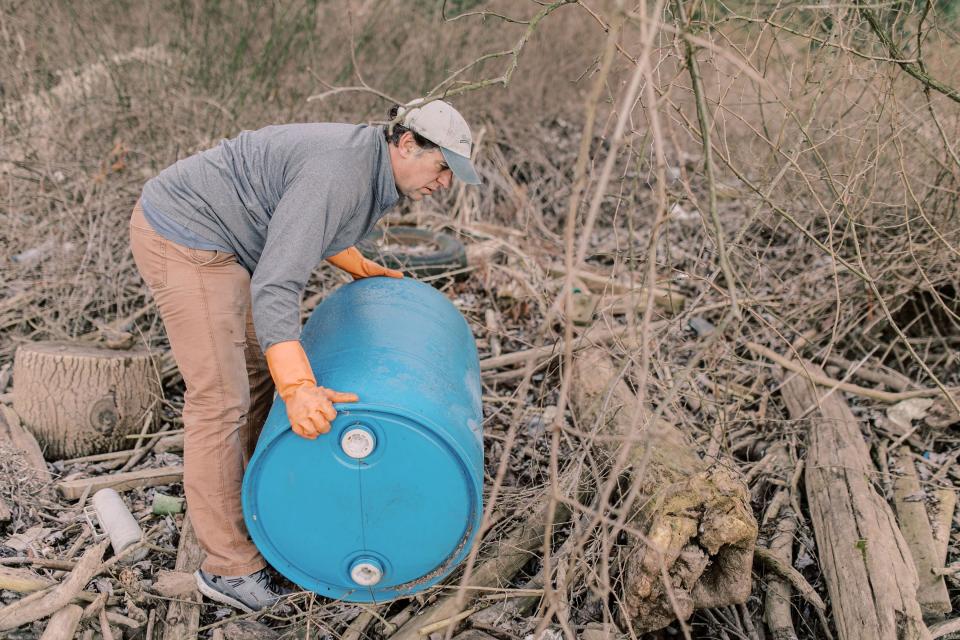York man has pulled 26,000 pieces of trash from the Susquehanna - 1 boatload at a time
How long does it take to remove 26,400 pieces of trash from the Susquehanna River?
John Naylor found out. One boatload at a time. It took him six years, one month and eight days. The 58-year-old “lifelong Yorker” reached his goal on March 19.
Every piece of trash added up. From flip flops to patio furniture, tires, traffic cones and bumpers, he found just about everything in the river.
“You name it — it’s in there,” said Naylor. “The scariest things are baby dolls — they’re not pretty anymore. But the worst things to me personally are motor oil and the sheer volume of single-use plastic bottles.”

One man’s trash
Naylor’s personal campaign to clean up the river began innocently enough in 2017, when a friend challenged him to stop complaining about trash in the river and do something about it.
His original goal was to clean 1,000 pieces of litter from the Susquehanna.
“I hammered that,” he said, hitting the goal in three months. So, he set his sights higher — at 26,400 — a number he chose because, in his day job at Manchester’s Starbucks Roasting Plant, there are 26,400 water bottles in one truckload.
Naylor chipped away at that goal with boatloads of trash — typically 100 to 300 pieces per haul — in one of his hand-paddled canoes or his small, motorized aluminum jon boat, christened “Susquehanna Retriever” on the side.
Focusing a few miles north and south of the Codorus Creek’s confluence with the Susquehanna, Naylor headed out on the river several times a week. It might sound like a solitary activity, but he said nature kept him company — eagles, ospreys, herons and turtles on logs.
Naylor made a lot of friendly human connections as well.
“When I’m out there picking, people are always waving, stopping to have conversations — and that’s a big part of it,” said Naylor. He looked at every encounter as an opportunity — to ask people to evaluate their habits, especially of single-use plastics.
Killing the Chesapeake: PA's polluted Susquehanna River is poisoning the bay. What can be done
Once people understood Naylor’s goal, many were quick to offer help: Residents let him park his boat — heaped with plastic bottles and debris — on ramps, while others offered him rides in the backs of their trucks, to his own pickup truck. His green ’92 Ford Ranger, bought new, has logged 284,000 miles — many of them traveled up and down the river, his boat trailer in tow.
At first, Naylor sorted “finds” into his own residential recycling and trash bins.
“Then, I bumped into a fellow in January of 2020, and he said, ‘I’ll get you a dumpster,’” Naylor recalled. “It was a little dumpster, and I filled it up in 18 days.”
Turns out, that “fellow” was Phil Wenger, CEO and president of the nonprofit Lancaster Conservancy.

“He connected me to another guy who said, ‘I can get you a bigger dumpster,” Naylor said, “And I’ve been rockin’ and rollin’ ever since.”
Naylor has filled six truck-sized dumpsters in the past three years and taken them to the York County Solid Waste Authority.
“It produces energy to generate electric power — so it goes from trash to electric,” Naylor said.
Those large dumpsters are coordinated by Ted Evgeniadis of the nonprofit Lower Susquehanna Riverkeeper Association.
“To remove thousands of pounds of trash — to lead an effort like that is so noble,” said Evgeniadis, who invited Naylor to become a board member. “We value John — he’s doing his part to improve such a massive watershed. If more people were like John, our river would be a lot cleaner.”
Ripple effects
Trash winds up in the river, Evgeniadis said, due to two primary reasons: human negligence or littering, as well as storm damage.
Naylor documented his expeditions on Instagram @susquehanna_plastic_pickn_1000, “using social media for environmental good,” he said. “It’s really about bringing exposure to water quality issues like microplastics.”
A 2019 study by the Chesapeake Bay Program found microplastics to be “ubiquitous throughout the region,” present in every water sample taken throughout the bay’s watershed. Plastic doesn’t decompose but breaks down into tiny pieces — microplastics — defined as less than 5mm in size.
Microplastics remain in the environment indefinitely and are ingested by wildlife and humans alike. A British study found that the average person, worldwide, eats and drinks 5 grams of plastic every week — about the weight of a credit card.

Naylor said he draws environmental inspiration from Ocean Clean Up, a nonprofit developing innovative methods of scooping plastic from the ocean — also documented on social media. What Naylor accomplishes through grassroots-style boatloads, the Ocean Clean Up does with huge nets and barges. Eight million metric tons of plastic washes into the world’s oceans every year, according to the National Oceanic and Atmospheric Administration (NOAA).
On a local level, Naylor hopes his images of the Susquehanna raise awareness — those depicting the river’s natural beauty, as well as its trash-strewn shores.
“Open your eyes — you can’t not see this,” said Naylor, “I love the Susquehanna River, but when you read about the health of the Susquehanna and the Chesapeake Bay, I can’t personally be OK with the nonchalance of how we treat our planet and living things.”
The Susquehanna, as the largest tributary of the Chesapeake Bay, supplies half of its freshwater. But perhaps surprisingly, a 2021 study found that 94% of the microplastics entering the Chesapeake Bay actually stay in the bay, which acts like a swirling sink. Instead of floating into the ocean, most microplastics are captured — and remain — in the bay.
Naylor’s bond to the river is stronger than ever. He’s looking forward to retirement, because “health willing,” he’ll have more time for river cleanups. In the meantime, he’s set a new goal: removing 10,000 pounds of trash from the river — a feat he estimates will take him a year and a half.
“Someone once said to me, ‘You know you can’t clean an entire river.’ That person really regrets saying that,” Naylor said with a laugh.
Karen Hendricks is a freelance writer.

This story appears as part of Climate Solutions, a collaboration focused on community engagement and solutions-based reporting to help Central Pennsylvania move toward climate literacy, resilience and adaptation. The York Daily Record is a Climate Solutions partner.
This article originally appeared on York Daily Record: York man pulled 26,000 pieces of trash from the Susquehanna

